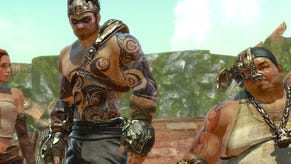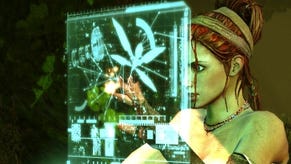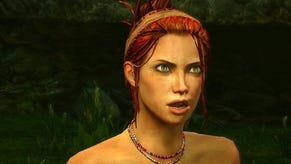Enslaved: Odyssey to the West
Monkey brawl.
Tameem Antoniades, Ninja Theory's chief creative ninja - that's according to the business card - looks like he's been yanked back in time from some promising point in the dim future where videogame designers exist in the same social troposphere as Hollywood actors and hip-hop personalities. His face has something of a young Bill Murray's charming cragginess to it, which blends well with the fact that he appears to have borrowed Johnny Cash's hair for the day.
Sat wearing a double-breasted pin-stripe jacket, Lady Gaga sunglasses and huge leather boots (their sartorial brilliance lies either with the fact that they were once very, very expensive or luminously cheap) you could be forgiven for thinking that he's hanging out in the bar of an upmarket London hotel on an afternoon in March to discuss what it's like to work with Bowie, or explain why he took time off from the difficult second album to launch his own line of luxury four-slice toasters.
Instead, he's here to talk about rust. Here's what he has to say on the subject: "You think about rust and you assume it's all the same: dull brown, a bit ordinary. But that's not the case. When you really get into it, you can get all kinds of rust: green rust, bright blue rust, yellows and silvers. Rust is amazing."
Antoniades is talking about rust because he's eager to explain that not everybody's take on what happens after an apocalyptic disaster has to look the same. His certainly doesn't. Most games suggest the aftermath of civilisation's collapse will be "dull brown" and "a bit ordinary". Ninja Theory launches things in another direction.
These are the stats: 150 years after the world ends in a muddle of nuclear whimpers and drone warfare, the population of the US stands at around 50,000. The landscape is sparsely populated, but it's still perilous, riddled with aging military robots too stupid to stop fighting.

But here are the snapshots: with Fox News and all those pesky Chinese sock factories out of the way, nature has clawed its way back into prominence, sending creepers and vines spilling over the decaying bones of cars and lorries, towns and cities. Urban skyscraper canyons burn red with swaying fields of poppies, mechanical graveyards look more like grottoes than scrap piles as they ripple with clear pools of shimmering water, and New York City is a vast, echoing nature reserve, bisected by a huge, and fairly pretty tectonic rift.
This is the world of Enslaved: Odyssey to the West. Ninja Theory's latest is inspired by the Eastern classic, Monkey: Journey to the West, and is a game that Antoniades hopes will confound your expectations at every turn. "There's always a twist to what we're doing, hopefully," he says. "It's the end of the world, but everything's so pretty. And the landscapes are beautiful, but they're also deadly."
Speaking of confounding expectations, Enslaved is another acrobatic action game, but if you're hoping for a spiritual successor to Heavenly Sword - all carefully separated combat arenas and intricate fighting stances - you'll be disappointed. "We spent months on Heavenly Sword giving the combat depth," says Antoniades, briefly looking like he might want to snap his sunglasses in half. "It was all about these huge combo strings to pull off special moves. I don't know how many people really put the effort in for all that in the end. Enslaved takes it in the other direction: tactical depth rather than mechanical depth."








